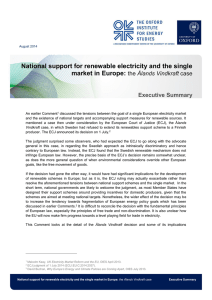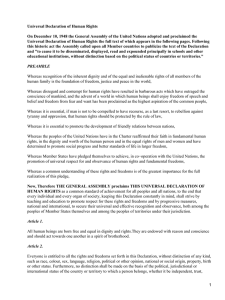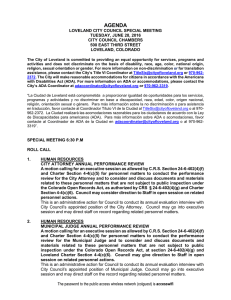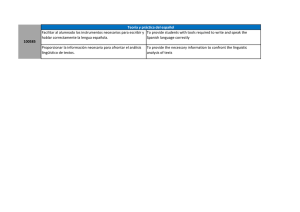- Revista Universitaria Europea (RUE)
Anuncio
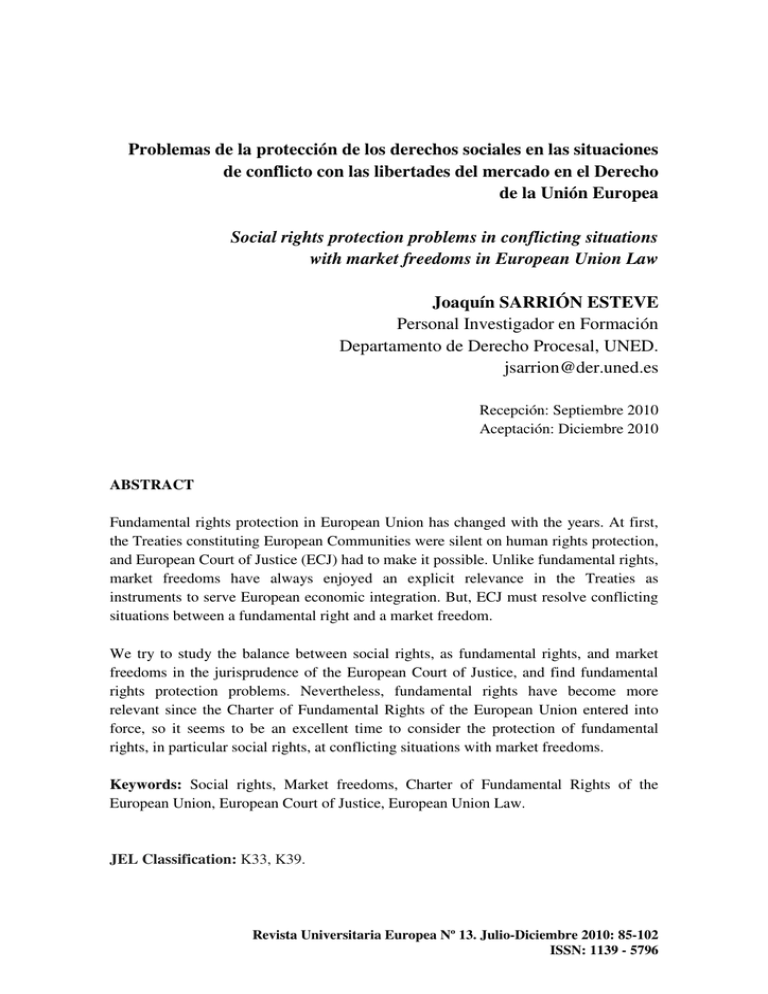
Problemas de la protección de los derechos sociales en las situaciones de conflicto con las libertades del mercado en el Derecho de la Unión Europea Social rights protection problems in conflicting situations with market freedoms in European Union Law Joaquín SARRIÓN ESTEVE Personal Investigador en Formación Departamento de Derecho Procesal, UNED. [email protected] Recepción: Septiembre 2010 Aceptación: Diciembre 2010 ABSTRACT Fundamental rights protection in European Union has changed with the years. At first, the Treaties constituting European Communities were silent on human rights protection, and European Court of Justice (ECJ) had to make it possible. Unlike fundamental rights, market freedoms have always enjoyed an explicit relevance in the Treaties as instruments to serve European economic integration. But, ECJ must resolve conflicting situations between a fundamental right and a market freedom. We try to study the balance between social rights, as fundamental rights, and market freedoms in the jurisprudence of the European Court of Justice, and find fundamental rights protection problems. Nevertheless, fundamental rights have become more relevant since the Charter of Fundamental Rights of the European Union entered into force, so it seems to be an excellent time to consider the protection of fundamental rights, in particular social rights, at conflicting situations with market freedoms. Keywords: Social rights, Market freedoms, Charter of Fundamental Rights of the European Union, European Court of Justice, European Union Law. JEL Classification: K33, K39. Revista Universitaria Europea Nº 13. Julio-Diciembre 2010: 85-102 ISSN: 1139 - 5796 Sarrión, J. RESUMEN La protección de los derechos fundamentales en la Unión Europea ha evolucionado con el paso de los años. En un principio, los Tratados constitutivos de las Comunidades Europeas guardaban silencio sobre la protección de los derechos humanos, y tuvo que ser el Tribunal de Justicia quien la hiciera posible. En cambio, las libertades del mercado siempre han disfrutado de una explícita relevancia en los Tratados como instrumentos al servicio de la integración económica europea. Pero el Tribunal de Justicia tiene que resolver situaciones de conflicto entre derechos fundamentales y libertades del mercado. Nosotros tratamos de estudiar la ponderación entre los derechos sociales, como derechos fundamentales, y las libertades del mercado en la jurisprudencia del Tribunal de Justicia, así como encontrar los problemas de la protección de los derechos sociales. Por otro lado, los derechos fundamentales han adquirido una mayor relevancia con la adquisición de fuerza jurídica de la Carta de los Derechos Fundamentales de la Unión Europea, por lo que parece ser un excelente momento para considerar la protección de los derechos fundamentales, y en particular de los derechos sociales en las situaciones de conflicto con las libertades del mercado. Palabras Clave: Derechos sociales, libertades del Mercado, Carta de los Derechos Fundamentales de la Unión Europea, Tribunal de Justicia de la Unión Europea, Derecho de la Unión Europea. Clasificación JEL: K33K39. RUE Social rights protection problems in conflicting situations with market freedoms in European Union Law 1. INTRODUCTION There is no doubt that most of social rights are fundamental rights in European Union Law (Menéndez, 2003: 187). However, we are not quite sure about how European Court of Justice (ECJ) protects them, in particular in the resolution of conflicting situations with market fundamentals freedoms. Fundamental rights protection in European Union has changed with the years. At first, the Treaties constituting European Communities were silent on human rights protection, and ECJ had to make it possible. Unlike fundamental rights, market freedoms have always enjoyed an explicit relevance in the Treaties as instruments to serve the attainment of market and economic integration. We leave aside the “conceptualization” of market freedoms like fundamental rights, question discussed in the literature; but clear in the jurisprudence of the Court , where ECJ referred to them in that sense: Forcheri v. Belgium (1983); UNCTEF v. Heylens, (1987); Dounias v. Minister for Economic Affairs (2000). The relevance of market freedoms and the second place of fundamental rights, in particular social rights, has been criticized (Poiares Maduro, 1999: 449). Nevertheless, fundamental rights have become more relevant with the acquisition of legal force by the Charter of Fundamental Rights of the European Union, so it seems to be an excellent time to consider the protection of fundamental rights, in particular social rights, in conflicting situations with market freedoms, Treaty of Lisbon. 2. FUNDAMENTAL RIGHTS AND MARKET FREEDOMS: RELATIONSHIP AND CONFLICT There are two types of relationship between fundamental rights and market freedoms: a positive relationship where fundamental rights serve to protect market freedoms; and conflicting situations where fundamental rights and market freedoms come in to direct conflict with each other, and for this reason the ECJ must balance them. In the first type of relationship, the most representative cases begin with ERT (1991) where the ECJ stipulates that Member States must respect fundamental rights when implementing Community law. Moreover, this respect is also required when dealing with an exclusion of treaty obligations. Therefore, a measure restricting market freedom must not only be justified, it should also respect fundamental rights as general principles of Community law. Revista Universitaria Europea Nº 13. Julio-Diciembre 2010: 85-102 ISSN: 1139 - 5796 Sarrión, J. The idea behind the doctrine established in ERT is that both market freedoms as well as any restrictions on them must take account of fundamental rights. In this case, it was free movement of services with freedom of expression.The line case continued with Karner (2004) about free movement of goods in relation to freedom of expression; Carpenter (2002) about free movement of persons and workers regarding the right to family life; and in the same line of Carpenter, Commission v. Kingdom of Spain (2006), Commission v. Federal Republic of Germany (2006). Anyway, a positive synergistic relationship is not a problem to social rights protection. It is in conflicting situation when problems came out. In fact, the question is: “When a fundamental right meets a fundamental freedom-which one prevails? How fundamental really is ‘fundamental’?” (Krzeminska-Vamvaka, 2005: 2). In these conflicting situations, two stages can be distinguished in case law. A first stage where we could see that there have been conflicting situations between fundamental civil rights and human dignity in front of market freedoms; 2) On the other hand, a second stage characterized by conflicting situations between social rights and market freedoms, in particular freedom to provide services. In the first stage, we find Schmidberger (2003), and Omega (2004); while in the second stage we find Viking (2008); Laval (2008); and finally Commissión v. Germany (2010). Different cases are Rüffert (2008), and Commission v. Luxembourg (2008), because they aren’t conflicting cases involving a social right, but to the workers protection as an objective.While in Schmidberger and Omega the Court considered that the restriction of a market freedom was justified in terms of protection of fundamental rights (the right to freedom of assembly and demonstration, and the right to human dignity, respectively). In a conflicting situation between social rights and freedom to provide, services as we shall see, the solution adopted by ECJ it different. So, how fundamental really are social rights? 3. SOCIAL RIGHTS AS FUNDAMENTAL RIGHTS In the introduction we said that there was no doubt that most of social rights are fundamental rights in European Union Law. Of course, if we study the ECJ case law, we see it clearly, for example in the representatives Viking and Laval cases. And it’s clear in the law literature after these cases (Fudge, 2007: 29-66). Moreover, social rights are included in the Charter of fundamental Rights of the European Union, in Section IV of the Charter, named with the expression “Rights to Solidarity”. Of course, not every right to solidarity are social or labour rights, only work-related rights to solidarity. It’s RUE Social rights protection problems in conflicting situations with market freedoms in European Union Law also possible to understand that “not all rights are granted equal status”, and make a typology of legal positions in the Charter (Menéndez, 2003: 183-187). In this sense, in a Menéndez’s table we can see the difference between fundamental rights, ordinary rights, and policy clauses of work-related rights to solidarity. (Menéndez, 2003: 183-186): 1) The distinction is based on an attractive interpretation of article 51 of the Charter: Fundamental rights are claims that could be used against the action of the ordinary legislator. Of course the ordinary legislator can regulate them, but must respect their essence: Fundamental rights: right to work (article 15), collective bargaining and action (article 28); working conditions respecting health and safety at work, and limited working hours and paid holidays (article 31.1 and 2). 2) Ordinary rights (clauses that refer to national legislation to determine the substantive contained of the right): worker’s right to information and consultation within the undertaken (article 27); protection in the event of unjustified dismissal (article 30). 3) Policy clauses are norms that require public institutions to achieve a certain objective Policy clauses: protection of the family (article 33.1); consumer protection (article 38). With Lisbon Treaty, the European Union Charter of Fundamental Rights enters into force. What impact will the Charter have on the balance between social rights and market freedoms? As we know, the Charter reinforces limits on the power of the EU, as sow articles 6.1 EUT, and 51.2 of the Charter (Gómez Sánchez, 2008: 507), and it was an important tool for legitimate European Union, and did not provide for any new rights (Goldmisth, 2001: 1201-1216). Moreover, the Charter “further the development of a more articulated system of fundamental rights, encouraging a rebalancing of different goals of European integration”, so social rights could be used as an argument for claiming exceptions to the four freedoms (Menéndez, 2003: 192); and the Charter might contribute to a conflicting situation in which fundamental rights and market freedoms are ranked at the same level (Lindfeldt, 2007: 216).Certainly, article 6.1,3 of EUT provides that rights, freedoms, and principles in the Charter must be interpreted in accordance with Title VII of the Charter. In relation of scope and interpretation of rights and principles, article 52 of the Charter, stipulates that when the Charter contains rights which correspond to rights guaranteed Revista Universitaria Europea Nº 13. Julio-Diciembre 2010: 85-102 ISSN: 1139 - 5796 Sarrión, J. by the Convention for the Protection of Human Rights and Fundamental Freedoms (ECHR), “the meaning and scope of those rights shall be the same as those laid down by the said Convention. This provision shall not prevent Union law providing more extensive protection” (article 52.3 Charter); and when the Charter recognizes rights resulting of common constitutional traditions of Member States, these rights must be interpreted in harmony with them (article 52.4 Charter) (Mangas Martin, 2010: 826850). In these two paragraphs the art. 52 is establishing the link between the rights enshrined in the Charter with the ECHR and common constitutional traditions in Member States, which are the sources of fundamental rights recognized by the Court of Justice as general principles of Community Law. The reason of this provision is to exclude any kind of conflict between fundamental rights protection standards. So we can understand that art. 53 provides a limitation on the scope of applicability of the Charter, to prevent a lesser level fundamental rights protection. In this sense, it is equivalent to ask for the highest fundamental rights protection standard of as a “principle of non-regression”. This would mean that the Charter only produces legal effects to Member States if they do not guarantee a higher level of protection, in which case the Charter should be applied (Ridola, 2002: 92), or “should make utterly clear that the Community rights should be interpreted, in line with national constitutional traditions, in such a way as to offer a high standard of protection” (Giubboni, 2003: 15). Social rights in conflicting relationship with marked freedoms in Viking and Laval cases were fundamental rights, because ECJ recognize them. Moreover, in Commission v. Germany, after the Charter entered into force, social right in conflict is fundamental too. In this way, ECJ had to balance fundamental social rights with market freedoms. How ECJ held the balance? Is a better balance possible? 4. SOCIAL RIGTHS AND MARKET FREEDOMS: AN IMPOSSIBLE BALANCE? While in the early conflicts between fundamental rights and economic freedoms (Schmidberger and Omega), the balance seemed to benefit fundamental rights (in particular freedom of expression and protest against the free movement of goods, and dignity against human freedom to provide services, respectively); it does not seem that social or labour rights have been a comparable fortune. RUE Social rights protection problems in conflicting situations with market freedoms in European Union Law 4.1. Colective actions and free service freedom 4.1.1. Viking Line case As we noted, the ruling on the occasion of the Viking case (2007), is the first in which we find a direct confrontation between social economic freedoms and fundamental labor rights. A Finnish ferry company, Viking Line, was responsible for carrying out a naval route between Tallinn (Estonia) and Helsinki (Finland) under a Finnished flagged ferry. At one point Viking Line sought to re-flag Rosella, so it would be able to benefit from lower working costs, because Rosella showed inability to compete against Estonian ships in the same route. But it was prevented to take place by Finnish Seamen’s Union (FSU) with the support of International Transport Workers’ federation (ITF), with a strike. After Estonia became a European Union Member State, Viking brought the matter before a English Court, and asked for an order to stop any action to prevent the re-flagging of Rosella, because it constituted a restriction on the freedom of movement. The English Court turned to the ECJ and asked if these actions constituted a restriction on the freedom of movement. Advocate General Maduro reasoned the state of the right to collective action as fundamental right, but he considered there was not a hierarchy of social policy objectives and the objective of the construction of common market. On the contrary, the Treaty reflects the aim to balance these policies. Moreover, “This touches upon a major challenge for the Community and its Member States: to look after those workers who are harmed as a consequence of the operation of the common market, while at the same time securing the overall benefits from intra-Community trade”. Finally, he concluded that article 43 ECT does not preclude trade unions from taking collective action with the effect of restricting a market freedom, and recommended to leave to the national court to determine whether the action taken was lawful. Assuming the proposals of the Advocate General, ECJ held that the right to collective action is a fundamental right. But the taken actions constituted a restriction of the freedom of establishment. It was necessary to examine whether the restriction was or not was justified. ECC pointed out that collective action could not be considered legitimate if it was established that the working conditions were not jeopardizes or under serious threat. Finally, it was left to the national court to determine whether the restriction was proportionate. A relevant question is the recognition of social rights as fundamental rights, as it was welcome (Davies, 2008: 26-28; Rodríguez-Piñero Royo, 2009: 96). But the judgment was seriously criticized because of the prevalence of market freedoms (Rodríguez-Piñero Royo, 2009: 96). Revista Universitaria Europea Nº 13. Julio-Diciembre 2010: 85-102 ISSN: 1139 - 5796 Sarrión, J. We consider that if it is true that recognition of social rights, as fundamental rights, is very relevant, the subordination of social rights to market freedoms is debatable. Nevertheless, once we exclude the existence of this subordination of social rights, the only appreciable difference with Schmidberger and Omega, is that ECJ did not finish proportionality test; and gave a series of criteria, leaving the decision to national court. 4.1.2. Laval case We are at the second confrontation between a social right and a market freedom. But social rights had been recognized as fundamental rights protected at EU level as general principles of Community law (Viking Line Case). However, the resolution is not exactly the same as in Viking Line case. “Laval un Partneri Ltd”, a Latvian company, posted Latvian workers to Sweden, to work on the construction of a school through Laval and Baltic Bygg AB (a subsidiary company). Laval had signed collective agreements with the Latvian trade unions, but not with the Swedish trade ones, because negotiations not come to fruition. The Swedish electricians’ trade union joined collective actions, and the work stopped. After that, Baltic Bygg was declared bankrupt and Laval brought proceedings a Swedish court for a declaration as to the lawfulness of the collective action and for compensation for the damage suffered. The Court turned to the ECJ and asked if Community law precludes trade unions form taking collective action in that situation. The Advocate General, Mengozzi considered that Community law was applicable to class actions, despite the importance of social rights not only in the ECHR, but also the European Social Charter; and the Charter of Fundamental Rights of the European Union, since having not yet entered into force the latter is an instrument that reflects fundamental rights resulting from constitutional traditions common to the Member States. But both these instruments as well as the Constitutions of the Member States recognized the possibility of imposing certain restrictions on the exercise of the right to take collective action. Moreover, to balance social rights and market freedoms the collective agreement conditioned by the trade had to be in conformity with article 3 of Directive 96/71 on the posting of workers, so to past the proportionality test it must involve a real advantage significantly contribution to social protection, to not duplicate the protection they had under the law or collective agreement applicable to the service provider in the Member State of establishment. RUE Social rights protection problems in conflicting situations with market freedoms in European Union Law Finally, Mengozzi proposed, in the way of Viking Line, the recognition of the possibility of taking collective actions to protect social rights, and leaving the decision for the national court, in the way of Viking Line case. ECJ held, in the way of Viking Line, that the right to collective action is a fundamental right. But the actions taken constituted a restriction of the freedom of establishment, and it was necessary to examine whether the restriction was or not justified and proportionate. Nevertheless, the difference between Laval and Viking is that in Laval, ECC was much more precise in its judgment and the application of proportionality test. In fact, ECJ considered that collective action would not be justified in relation to the objective of protecting workers. In this case, it has been confirmed again the importance of the recognition of collective action as a fundamental right, despite the prevalence of market freedom (De la QuadraSalcedo Janini, 2008: 836-839). However, the solution was not the Viking one. ECJ did not leave the resolution of the balance to national court. Therefore, this is very important, because despite in Viking Line case, in Laval one, it seems impossible for the national court not to balance in favor of market freedom. The solution adopted in Viking, proposed by Advocate General Maduro, and in Laval proposed by Advocate General Mengozzi, seems more respectful to the protection of fundamental rights, because ensures the highest possible standard of protection. 4.2. Collective bargaining and free service market freedom: Commision v. Germania case This is the first judgment that resolves a conflict between fundamental rights, in particular social rights, and market freedoms after the entry into force of the Lisbon Treaty. Really, this one is a special case, different from Laval and Viking ones, because it was initiated by an action of the European Commission. The question was that local authorities have awarded service contracts in respect of occupational old-age pensions directly, without a call for tenders at European Union level, to bodies and undertakings referred to in a clause of a Collective Agreement (TVEUmw/VKA). Advocate General Trstenjak, considered that the most difficult question is the relationship between the rights bargain collectively and to autonomy in collective bargaining, and Directives 92/50 and 2004/18 witch give effect to freedom of establishment and freedom to provide services. The rights to bargain collectively and to autonomy in collective bargaining must be regard as general principles of Community Law, and as fundamental social rights, but Revista Universitaria Europea Nº 13. Julio-Diciembre 2010: 85-102 ISSN: 1139 - 5796 Sarrión, J. he concluded that “are incapable of justifying the restriction on freedom of establishment and freedom to provide services resulting from the preliminary selection adopted by the social partners (…) in favour of certain pension scheme providers because such restriction is not proportionate”. And ECJ follows this way. First, ECJ underlined that according to the particulars provided by the Federal Republic of Germany, pension insurance contracts have been awarded directly by local authority employers to bodies other than those referred in collective agreement, using the basis of the third sentence of paragraph 6 of the TV-EUmw/VKA. This sentence of the collective agreement enables local authority employers to do without an individual procedure for selecting the body to be entrusted with implementing the salary conversion measure; and these considerations cannot justify not applying European Union public procurement directives. Moreover, “compliance with the directives concerning service contracts does not prove irreconciliable with attainment of the social objective pursued by the signatories os the TV-EUmw/VKA in the exercise of their right to bargain collectively” (Para. 66) so concluded that the Federal Republic of Germany failed to fulfil its obligations. Since this judgment, it’s clear the applicability of the European Union public procurement contracts rules to municipals entities, including collective agreements clauses. In this case, we think the ECJ’s resolution is justified. Certainly, pension plan directly awarded by local authority employers, without public procedure rules, is an unjustifiable action, although based on a collective agreement. And however, this judgment has been criticized as “another damaging judgment for social Europe”. We think that a fundamental right don’t must be used in this sense, because it could lose its purpose. 5. CONCLUSIONS Really, social or labor rights are fundamental rights in European Union Law. ECJ recognized them as general principles of Community Law in the judgments analyzed. But, the fundamental status of social rights is similar to fundamental status of market freedoms. So, we can argue when the two interests came into a conflicting situation, ECJ needs to balance them. This balance is very relevant because we are speaking about fundamental rights protection, so we hope for a fair balance.Nevertheless, while in the early conflicts between fundamental rights and economic freedoms (Schmidberger and Omega), the balance seemed to benefit fundamental rights, in the conflicts between social or labour rights and market freedoms, the solution was different. In these balances, we can distinguish different approaches from the Court, so not all conflicts are resolved identically. In this sense, ECJ applies a case-by-case analysis. RUE Social rights protection problems in conflicting situations with market freedoms in European Union Law One can see Viking Line case, where ECJ leaved national court to examine whether the restriction, caused by collective actions, was or not was justified and proportionate. Of course, with any basis or criteria, but the decision is leaved to national court. On the other hand, in Laval case ECJ did not leave the resolution of the balance to national court, because ECJ finished proportionality test, and the balance was clearly to benefit marked freedom. In Commision v. Germany case, is an different, because it played by an European Commission action. ECJ concluded that Germany failed to fulfil its obligations under the Treaties. In this case, a fundamental right like right to bargain can’t justify a directly award of pension plans by local authority employers. It’s clearly that a fundamental right can’t be used in this sense. But looking at Viking and Laval judgments, I would prefer Viking. In my opinion, after the Lisbon Treaty, to ensure fundamental rights protection, we need the highest possible fundamental rights protection standard, interpreting in this way articles 52 and 53 of the Charter of Fundamental Rights of the European Union. So, the solution adopted in Viking, proposed by Advocate General Maduro, and in Laval proposed by Advocate General Mengozzi, seems the best one. Because this solution ensures the highest possible standard of protection, leaving national court to decide whether the collective action (as fundamental right) was or not was justified and proportioned. Since European Union Charter of Fundamental Rights Charter entered into force, it is relevant to guarantee a higher fundamental rights protection standard (arts. 52.2, 4, in relation with article 53 of the Charter). And it is only possible if ECJ leave national the final balance, of course with any criteria to resolve the conflict. As we know, Constitutional Courts have not accepted peacefully the primacy of Community law over national law, especially constitutional law, and in particular fundamental rights constitutional protection. This is evident, and paradigmatic in the case of German or Italian Courts. As a result, if ECJ chooses to resolve a conflict between market freedoms and social fundamental rights as the solution in Laval, deciding that the restrictive measures applied to protect fundamental rights in a Member State, is contrary to Community law; it may happen that although the national court respect the criteria, if the question arrived to Constitutional Court, (in case we are in a situation of a community question, and not in an infringement action); and fundamental rights protection standard is higher, the decision of the Constitutional Court could be in benefit of social fundamental right. In this sense, the future relation between ECJ and Constitutional Courts could be difficult. Revista Universitaria Europea Nº 13. Julio-Diciembre 2010: 85-102 ISSN: 1139 - 5796 Sarrión, J. We believe that fundamental rights protection, specially social rights one, in the European Union, underline problems of a multilevel system, which should always be solved through an inter-jurisdictional dialogue. But this “dialogue” would be easier and better with the respect to the highest fundamental rights protection standard, what is more, with a perspective of European Union’s accession to the ECHR. Definitely, a better balance is possible. BIBLIOGRAPHY ASHIAGBOR, D. (2009): “Labor Rights in the Era of Globalization”, Law & Ethics of Human Rights, Vol. 3, Issue 2, pp. 220-266. BIONDI, A. (2004): “Free Trade, a Mountain Road and the Right to Protest: European Economic Freedoms and Fundamental Individual Rights”, European Human Rights Law Review, Issue 1, pp. 51-61. BOGDANDY, A. von (2000): “The European Union as an Human Rights Organization? Human Rights and the Core of the European Union”, Common Market Law Review, Vol. 37, pp. 1307-1338. DAUSES, M. A. (1985): “The Protection of fundamental rights in the Community legal order”, European Law Review, Vol. 10, Issue 6, pp. 398-419. DAVIES, A. C. L. (2008): “One Step Foward, Two Steps Back? The Viking and Laval Cases in the ECJ”, Industrial Law Journal, Vol. 37, Issue 2, pp. 126-148. DE LA QUADRA-SALCEDO JANINI, T. (2008): “TJCE-Sentencia de 18.12.2007, LAVAL, C-341/05-libre prestación de servicios-desplazamiento de trabajadores-la supuesta legalización del dumping social en el interior de la Unión Europea”, Revista de Derecho Comunitario europeo, Nº. 31, pp. 835-848. DIEZ PICAZO, L. M. (2005): Sistema de Derechos Fundamentales, Civitas, Madrid, (1ª ed. 2003). FUDGE, J. (2007): “The new discourse of lavour rights: from social to fundamental rights?” Comparative Lavor Law Policy Journal, Vol. 29, Issue 1, pp. 29 a 66. GIUBBONI, S. (2003): “Fundamental social rights in the European Union: Problems of protection and enforcement”, Second Expert Workshop Co-operation or Confrontation? Toward the Effectiveness of International Law, Conference Centre of the Catholic Academy, Berlin, [http://www.sef-bonn.org/download/ veranstaltungen/2003/2003_fachws_referat-giubboni_en.pdf ]. RUE Social rights protection problems in conflicting situations with market freedoms in European Union Law GÓMEZ SÁNCHEZ, Y. (2008): Derecho Constitucional Europeo. Derechos y Libertades, Sanz y Torres, Madrid, (1ª ed. 2003). GOLDSMITH, L. (2001): “A Charter of Rights, Freedoms and Principles”, Common Market Law Review, Vol. 38, Nº.5, pp. 1201-1216. KRZEMINSKA-VAMVAKA, J. (2005): “Free Speech Meets Free Movement: How Fundamental really is ‘Fundamental’? ZERP-Diskussionspapier, Nº.3 [http://ssrn.com/ abstract=1134809]. LEUPRECHT, P. (1999.): An EU Human Rights Agenda for the New Millenium, Hart Publishing, Oxford, pp. 449-472. LINDFELDT, M. (2007): Fundamental Rights in the European Union-Towards Higher Law of the Land? A Study of the Status of Fundamental Rights in a Broader Constitutional Setting, Åbo Akademi University, Åbo. MANGAS MARTIN, A. (2008): Artículo 52. Alcance e interpretación de los derechos y principios, en MANGAS MARTÍN, A. (Dir), Carta de los Derechos Fundamentales de la Unión Europea. Comentario artículo por artículo, Fundación BBVA, Bilbao, pp. 826-850. MENENDEZ, J. A. (2003): Rights to Solidarity’ balancing Solidarity and Economic Freedoms, en ERIKSEN, E., FOSSUM, J., MENÉNDEZ, J. (eds.) Chartering of Euroope, the European Charter of Fundamental Rights and its Constitutional Implications, Nomos, Baden-Baden, pp. 179-198. MORIJN, J. (2006): “Balancing Fundamental Rights and Common Market Freedoms in Union Law: Schmidberger and Omega in the Light of the European Constitution”, European Law Journal, Vol. 12, Nº. 1, pp. 15-40. PERISIN, T. (2006): “Interaction of fundamental (human) rights and fundamental (market) freedoms in the EU”, Croatian Yearbook of European Law and Police, Vol. 2, pp. 69-98. PEREZ DE LAS HERAS, B. (2008): El mercado interior europeo: las libertades económicas comunitarias: mercancías, personas, servicios y capitales, Universidad de Deusto, Bilbao (1ª ed. 2004). POIARES MADURO, M. (1999): Striking the Elusive Balance Between Economic Freedom and Social Rights in the European Union, en ALSTON, P., CASSESE, A. LALUMIÈRE, C. y RODRIGUEZ IGLESIAS, G.C. (1995): “The Protection of Fundamental Rights in the Case Law of the Court of Justice of the European Communities”, Columbia Journal of European Law, Vol. 1/2, pp. 169-181. Revista Universitaria Europea Nº 13. Julio-Diciembre 2010: 85-102 ISSN: 1139 - 5796 Sarrión, J. RODRIGUEZ-PIÑERO ROYO, M. (2009): “Libertades económicas y derechos sociales en la Unión Europea”, XX Congreso Nacional Asociación Española de Derecho del Trabajo y de la Seguridad Social, Logroño. [www.aedtss.com/ TERCERA_PONENCIA_MRPR.doc]. RIDOLA, P. (2002): La Carta dei diritti fondamentali dell’Unione Europea e la “tradizioni costituzionali comuni” degli Stati membri, en PANUNZIO, S.P. y SCISO, E., Le riforme istituzionali e la partecipazione dell’Italia all’Unione europea, Giuffrè, Luiss Edizioni, Milán. WEILER, J. H. H. (2006): The Essential (and would-be Essential) Jurisprudence of the European Court of Justice: Lights and Shadows too, en PERNICE, I., KOKOTT, J. y SAUNDERS, C. (eds) The Future Of The European Judicial system in a Comparative Perspective, Nomos, Baden-Baden, pp. 117-127. REFERENCES 1 We don’t want to enter into the literature discussion about the concept of "fundamental rights" and the distinction with the concept of "human rights". However, it is necessary to define the meaning we give to these terms in these lines. We take for good the distinction made by Diez Picazo, in the sense that the difference between human and fundamental rights would be based on the system that recognizes and protects them: internal, in the case of fundamental rights, international, for human rights. Of course, European Union Law is in the ambit of International law, however, given the peculiarities of European Union, it’s commonly used the term “fundamental rights” (Díez Picazo, 2005: 389). 2 About the crucial role of ECJ vid. Dauses (1985: 398-419); Rodriguez Iglesias (1995: 169-185); Weiler (2006: 117-127), Lindfeldt (2007: 68-78). 3 To study the evolution of market freedoms in European Union Law, vid. Pérez de las Heras (2008). 4 About the literature, believing that the conceptualization exist vid. KrzeminskaVamvaka (2005: 5-6), Poiares Maduro (1999:452), Lindfeldt (2007:196-208), Ashiagbor (2009:237). Against this point of view, Bogdandy (2000: 1326-1327). 5 In this sense vid. Biondi (2004: 53-54). 6 Forcheri v. Belgium, C-152/82, para. 11, refered to free movement of workers. 7 UNCTEF v. Heylens, C-222/86, para. 14, refered to free movement of workers. RUE Social rights protection problems in conflicting situations with market freedoms in European Union Law 8 Dounias v. Ipourgos Ikonomikon (Minister for Economic Affairs), C-228/98, para. 64, refered to free movement of goods. 9 We use the term “social rights” to refer labour rights as it is generally used in literature (Rodríguez-Piñero Royo, 2009; Fudge, 2007). 10 Lisbon Treaty enter into force last 2 December 2009, and with it the Charter of Fundamental Rights of the European Union. 11 ERT v. DEP, C-260/89. 12 Herbert Karner Industrie-Auktionen GmbH v. Troostwijk GmbH, C-71/02. 13 Mary Carpenter v. Secretary of State for teh Home Department, C-60/00. 14 Commission v. Kingdom of Spain, C-505/03. 15 Commission v. Federal Republic of Germany, C-441/02. 16 Eugen Schmidberger, Inernationale Transporte und Planzüge, C-112/00. 17 Omega Omega Spielhallenund Automatenaufstellungs-GmbH Oberbürgermeisterin der Bundesstadt Bonn, C-36/02. 18 International Transport Workers’ Federation and Finnish Seamen’s Union v Viking Line ABP and OÜ Viking Line Eesti, C-438/05. 19 Laval un Partneri Ltd v. Svenska Byggnadsarbetareförbundet and others, C341/05. 20 Commission v. Federal Republic of Germany, C-271/08. 21 Dirk Rüffert v. Land Niedersachsen, C-346/06. 22 Commission v. Luxembourg, C-354/05. 23 About this first stage and balancing fundamental rights and market freedoms in Schmidberger and Omega cases see Morijin (2006: 15-33); Perisin (2006: 69-98). 24 Avocate General Maduro’s Opinion delivered on 23 May 2007 in Viking Line, C-438/05. 25 Para. 20-23. 26 Para. 60. 27 Para. 73. 28 Para. 44. v. Revista Universitaria Europea Nº 13. Julio-Diciembre 2010: 85-102 ISSN: 1139 - 5796 Sarrión, J. 29 Para. 84. 30 Avocate General Paolo Mengozzi’s Opinion delivered on 23 may 2007, Laval un Partneri Ltd v. Svenska Byggnadsarbetareförbundet and others, C-341/05. 31 Para. 38-86. 32 Para. 308. 33 Para. 91 34 Para. 101. 35 Para. 108-111. 36 Para. 110. 37 Advocate General Trstenjak’s Opinion delivered on 14 april 2010, European Commision v. Federal Republic of German, C-271/08. 38 Para. 3. 39 Para. 4. 40 Para. 233. 41 Para. 63. 42 Para. 64. 43 Para. 60-65. 44 Para. 105. 45 Words of John Monks, General Secretary of the European Trade Union Confederation (ETUC): “This is another damaging judgement for social Europe. The application of economic freedoms makes no sense at a time where, more than ever, practical solutions need to be found for the sustainability of pensions throughout Europe. This judgment ignores the public authorities’ independence when they are acting as employers. More worryingly, it also confirms the supremacy of economic freedoms over fundamental social rights. The dark series initiated by the Viking and Laval cases is far from being over. The ETUC renews its calls for urgent action by the European authorities to confirm that the EU is not just an economic project but has as its main objective the improvement of living and working conditions of its populations, and that the concept of social progress is of fundamental importance for keeping the support RUE Social rights protection problems in conflicting situations with market freedoms in European Union Law of Europe’s citizens and workers for the European project. The ETUC is pressing the case for a social progress clause in the EU Treaties to underline this point”. [http://www.etuc.org/a/7521] Revista Universitaria Europea Nº 13. Julio-Diciembre 2010: 85-102 ISSN: 1139 - 5796 Sarrión, J. RUE
